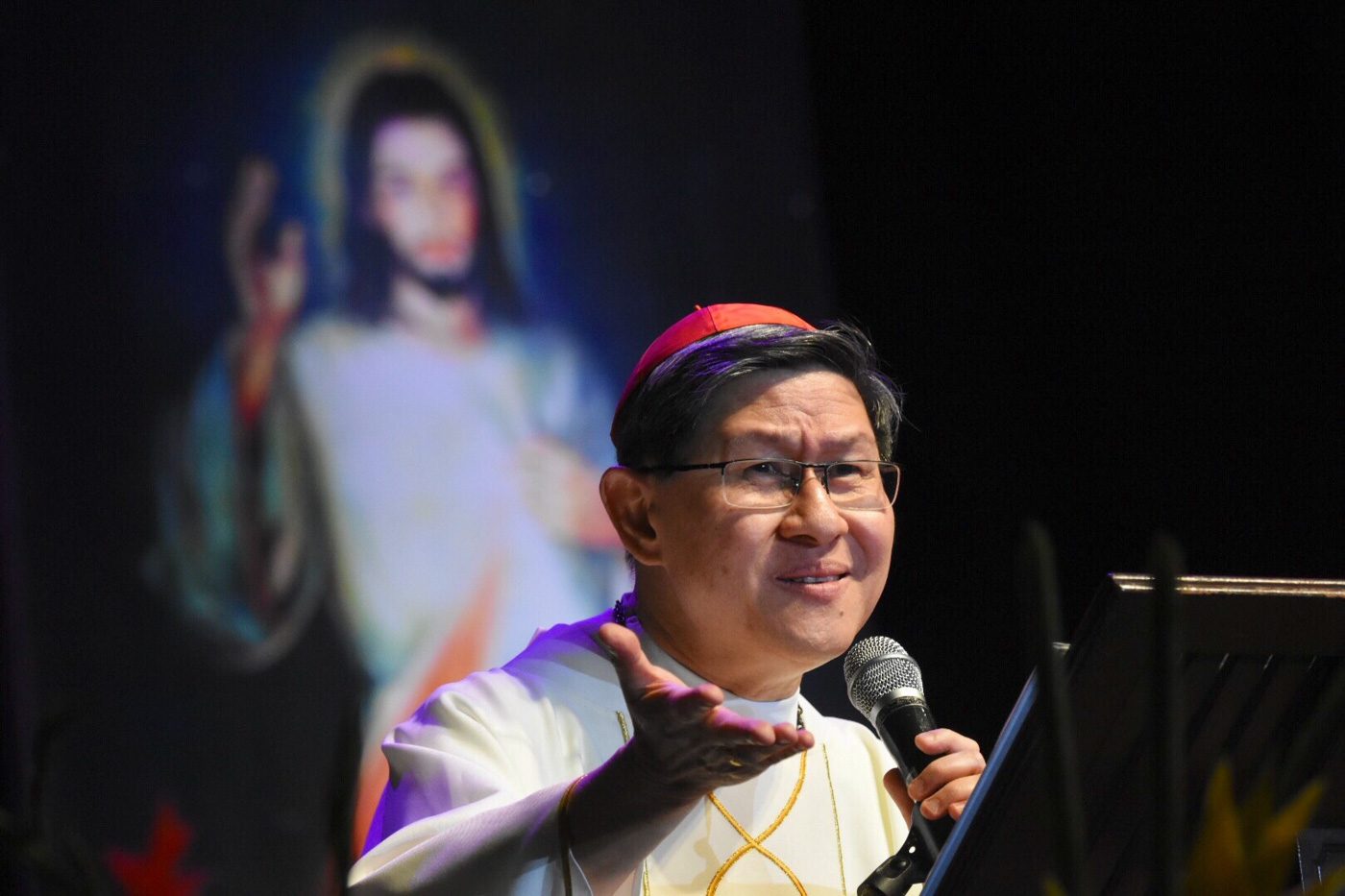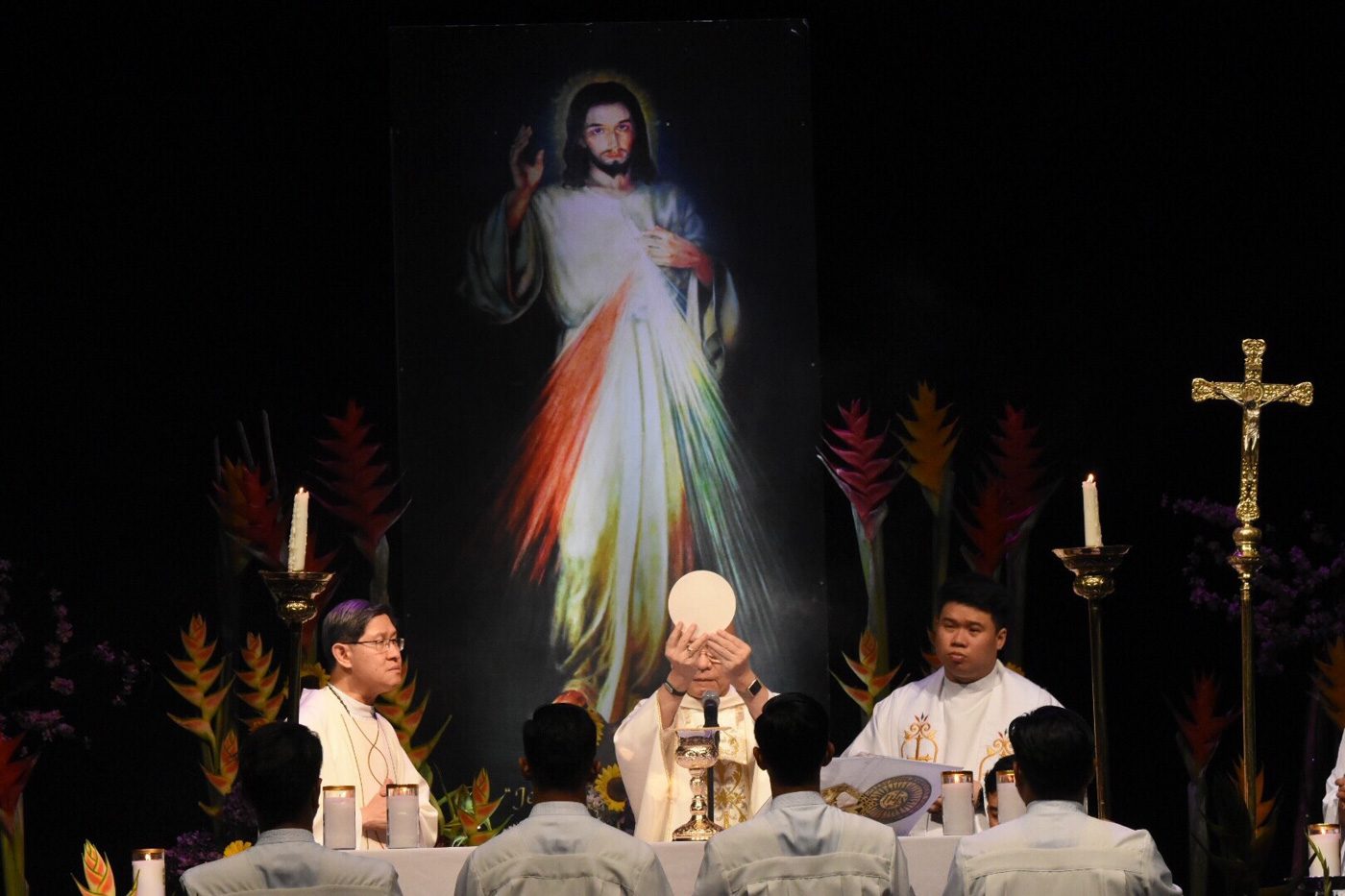SUMMARY
This is AI generated summarization, which may have errors. For context, always refer to the full article.

MANILA, Philippines – Manila Archbishop Luis Antonio Cardinal Tagle led an Easter recollection organized by Jesuit Communications on Sunday, April 8, a day that the Catholic Church worldwide celebrates as Divine Mercy Sunday.
Divine Mercy Sunday, a feast established by Pope Saint John Paul II to remind Catholics of the mercy of God, is celebrated annually on the first Sunday after Easter.
In his homily on Sunday, Tagle pointed to the image of the Divine Mercy, which shows a wounded Christ blessing the world. He focused his homily on Jesus’ wounds, which remained with him even after his Resurrection.
The Manila archbishop said: “How come the Risen Lord, the triumphant Lord, did not erase the signs of his death? If I were Jesus, triumphant, I would remove all signs, all memories, of my defeat, my shame, and humiliation. But that’s not the way of Jesus. It is important that the glorious life – life in God – must be able to carry ordinary wounds.”
He then tackled “wounds” of society, such as the scourge of hazing and the cycle of revenge. He called on his flock to “stop wounding others.”
“We see the true God only in the wounded Christ – wounded yet merciful,” Tagle added.
“So today, go. Touch, see the wounds of Christ in others. Have no fear. He will tell you, ‘Peace be with you.’ And hopefully, we can spread the Good News: ‘We have seen the Lord,'” the Manila Archbishop said.
Read below the full transcript of Tagle’s homily at the Word Exposed Easter Recollection at the Smart Araneta Coliseum on Sunday:
My dear brothers and sisters, we thank Bishop Honesto Ongtioco, the bishop of Cubao, for being with us and for presiding at the Eucharist. Palakpakan natin si Bishop. Every time we have a recollection here, it is by his permission that we are able to gather. So maraming salamat po. At gustong gusto niyang mag-homily (laughs). Kaya lang po may kontrata ako eh, tatapusin ko.
The second Sunday of Easter is called the Sunday of Divine Mercy. And as we see in the depiction of Jesus, the Lord of Divine Mercy, the wounds of Christ are very much present. And that’s the mystery of our Gospel. How come the Risen Lord, the triumphant Lord, did not erase the signs of his death? If I were Jesus, triumphant, I would remove all signs, all memories, of my defeat, my shame, and humiliation. But that’s not the way of Jesus. It is important that the glorious life – life in God – must be able to carry ordinary wounds.

We said earlier, we see the Lord, the extraordinary power of the Lord, in ordinary events. What is more ordinary than wounds? Sa pang-araw-araw na buhay, sugat ang isa sa pinaka-ordinaryo. Walang tao na hindi sugatan. Every person has some form of wounds.
You can recall what are your wounds. And do not think that sharing in the mystery of the Resurrection will remove the wounds. No! Even the Risen Lord has those wounds. And he shows them those wounds. He even tells them, especially to Thomas, “Touch my wounds. Put your finger here. Put your hand here.” Not only showing wounds but inviting us to look and to touch.
How is this related to Divine Mercy? Jesus assumes woundedness in his Resurrection. Niyakap, isinama, sa Muling Pagkabuhay. Ang sugat, hindi inalis. But Jesus transformed the wounds. By showing his wounds to the disciples, he reminded them, as he reminds us, of our capacity to inflict wounds.
Magandang paalalahanan tayo. Kaya nating magbigay ng sugat sa kapwa. When we see the wounds of other people, we should be reminded, I have also inflicted wounds. ‘Yung matalas na pagtingin, makakasugat ‘yan. Mamaya, communion, baka pagbalik mo sa upuan, may iba nang nakaupo. Naku, ang talas! Kakakomunyon mo lang, nansusugat ka na agad! ‘Yung maasim, maanghang na salita, nakakasugat tayo diyan. ‘Yung mga pagkakataon na inuna natin ang sarili, inuna natin ipagtanggol ang sarili kaysa ang kapwa, kaysa ang katotohanan, nakakadagdag tayo ng sugat.
Mahalaga na makita natin ‘yung sugatan, para mapaalalahanan tayo, kay daming sugat din ang ating naibigay.
But the beauty of Jesus’ showing his wounds was not in order to retaliate. He showed his wounds not in order to take revenge, not in order to shame the apostles. Siguro kung iba lang si Hesus. Halimbawa ako, halimbawa merong tumulak sa akin, nasugatan ako, tapos nakita ko ulit. Ipapakita ko sa kanya ang sugat ko, para ipamukha: “Kita mo ‘yan! Sinaktan mo ako! Eh kung ikaw kaya ang ingudngud ko diyan!”
Buti na lang, hindi ako si Hesus. Jesus showed his wounds and said, “Peace be with you.” And as I said earlier, he meant it. He did not want to inflict further wounds on those who had wounded him. In fact, through his wounds, he was inviting them: Let us stop wounding others. He understood his disciples. He knew they were also wounded.
‘No more hurting!’
And this is how to stop the cycle of wounding. Show the wounds not to retaliate, but to heal. The wounded one becomes a vessel of transformation of fellow wounded people.
Bakit palala nang palala ang mga hazing? Bakit palala nang palala ang mga initiation rites na may hazing? Kasi, “Noong ako ang na-initiate, nasaktan ako. ‘Yung gusto kong gumanti, ‘yan ay ipapasa ko ‘pag kami na ang nag-i-initiate.” Kaya taun-taon, palala nang palala! Kahit na may namamatay, hindi pa rin itinitigil!
Show the wounds, and let the wounds tell us: No more hurting! And we decide, we decide. “In my wounds, I will be a vessel of healing.” Baka mamaya, may hazing na naman. Hanggang kailan ‘yan? Hanggang kailan?
We, who have seen the wounds of the Lord, are asked to see him in the wounded people of the world. “I have seen the Lord.” They will tell you, “Where?” In the wounded. I have seen, I have touched, the wounds. And I tell you, by surprise, some, some of those who have seen the Lord in their wounds, become instruments of healing.
In the First Reading, the early Christian community healed indifference. They shared their goods with one another, and there was no one needy among them. Isang sugat ‘yan ng ating lipunan. Mayroong iba, sobra sobra, hindi alam ang gagawin sa kanilang pagkain at gamit. Namomroblema: “Punong puno na ang aking fridge! Makabili nga ng isa pang fridge.” Ang ganda naman ng problema mo! At hindi nakikita, may mga may sugat, ni hindi alam kung may makakakain mamaya.
Touch the wounds, and like the early Christian community, be a bit hungry so that others may be fed. Share your resources, but first see the wounds, touch the wounds, and then seeing Jesus, we can decide to be instruments of redemption through mercy.
Kapag hindi pa nakita si Hesus sa sugat ng iba, ang dala dala natin, revenge. ‘Pag nakita na si Hesus sa sugat ng iba, at sa sarili kong sugat, how God has been merciful to me, then I become an instrument of healing. And sana maraming tao, makakasabi, “We have seen the Lord.”
Ito naikuwento ko na ito eh, pero ikukuwento ko pa rin. Two years ago, ‘yung isa kong teacher, pinatawag ako, maysakit na siya, and eventually he died. Black Saturday ako pinatawag. Pagpasok ko sa kuwarto niya, nag-iiiyak. He was like a boy sobbing, and the nurse told me, when former students and friends visit Father, he gets emotional. So nilapitan ko, hinaplos-haplos ko ang balikat. Sabi ko, “Father, Father, you’re okay.” Nu’ng kumalma na, sabi niya, “Chito, you used to sleep in my class.” Naku po. Sabi ko, “Kaya pala ako pinatawag, sasabihan ako, ‘Naku Chito, tulog ka nang tulog sa klase ko.'” Sabi ko, “Father, I’m sorry. I’m sorry if I had caused you problems when I was your student.” Sabi niya, “No. You did well. But look, you are now a cardinal.”
Napaisip ako. Sabi ko, ano bang sinasabi ni Father? Siguro sinasabi niya, “Huwag kang mayabang ha! Huwag kang parang kung sino ha! Kilala ka namin! Tutulug-tulog ka lang!” He knew my wound, my weakness. And he understood it. Kaya ngayon, ‘pag may natutulog sa homily ko, hindi ako nagagalit! (laughter) Hindi ako nagre-retaliate. I see the wounds! My own wounds! At kung ako nga, na-redeem ‘yung aking pagtulog, sino ako para maghiganti sa mga natutulog sa akin? (laughter) Sige, matulog kayo! (laughter)
Ang galit na galit lang sa mga natutulog during their homily or their class, ay ‘yung nagpapanggap na hindi sila nakatulog. But if you are honest with your wounds, you will assume their woundedness. And then they will say, wow. One priest even asked me, “Your eminence, nu’ng seminarian ako, nakakatulog din ako sa klase. Do you think I could be a cardinal?” (laughter) Sabi ko, “Hindi ko na ‘yan kaya. Hindi ko na ‘yan kaya.” But why begrudge it? You are also wounded. And if Jesus can tolerate your wounds and assume your wounds, Jesus also slept. And he was castigated. So go. Close your eyes. (laughter) Basta make sure ako ‘yung nagle-lecture. Kapag iba, eh baka magalit sa inyo.
But it’s wonderful to see the Lord, in the wounded, without rancor, with a sense of justice, but with mercy, understanding.
‘Wounded yet merciful’
Finally, last Holy Thursday, for the Mass of the Lord’s Supper, in the Manila Cathedral, we invited people for the Washing of the Feet. Those who were wounded by displacement. The parents of Demafelis, the OFW who was killed and discovered in a freezer in Kuwait. We washed the feet of her parents. We washed the feet of a couple and their daughter, nakatira sa riles, na-evict, and now trying to find new life in Laguna. We washed the feet of a couple, both of them in the navy, kung saan-saan naa-assign, bihirang magkita. We washed the feet of two indigenous people, Lumads, who had to leave their land because of violence, because of environmental disaster.
And I washed the feet of Father Chito Soganub, the priest of Marawi who was taken hostage for more than a hundred days. And as I was washing his feet, all the wounds came out. Fear. He was crying. I think he shed more tears than the water that I poured on his feet. And he cried all the more when I kissed his foot. But he said, “My thoughts are still with our brothers and sisters, especially our brother Muslims, our sisters and brothers among the Muslims.” He said, “I suffered a lot, but they suffer all the more.”
Not wounds of anger, not wounds of retribution, but wounds, real wounds, that brought solidarity, that brought redemption. And I could only say, “I have seen the Lord.” And then we understand what Thomas said: “My Lord and my God.”
We see the true God only in the wounded Christ – wounded yet merciful.
So today, go. Touch, see the wounds of Christ in others. Have no fear. He will tell you, “Peace be with you.” And hopefully, we can spread the Good News: “We have seen the Lord.”
Let us pause and allow this mystery to be part of our daily living, as we encounter many wounded people in our day-to-day life.
– Rappler.com
Add a comment
How does this make you feel?
There are no comments yet. Add your comment to start the conversation.